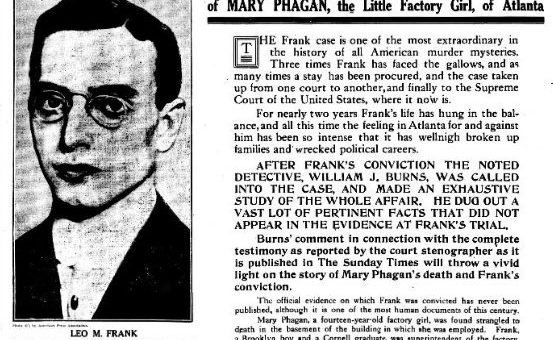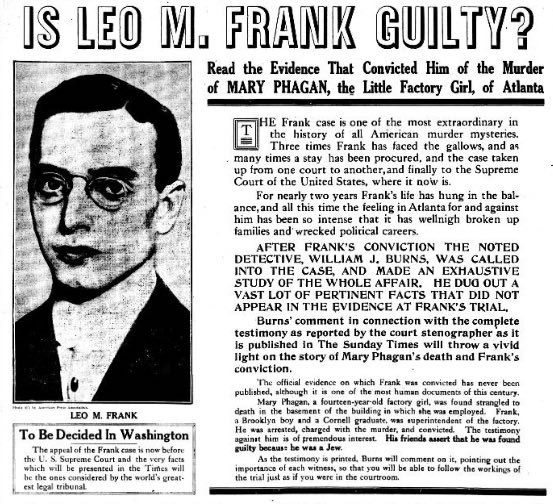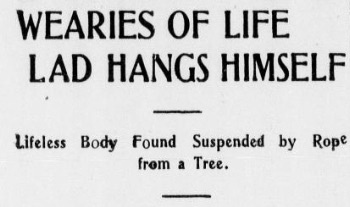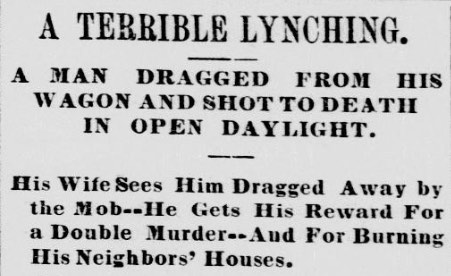
Not a day went by in the early 1900s when a body was not discovered hanging in a tree. Many of the deaths were self induced. Some were the infamous lynchings of mobs. A few were staged to cover up the act of murder.
1. Lynched for Rape and Murder
Mary Phagan’s lifeless little 14-year-old body was discovered on April 26, 1913 in Atlanta, Georgia. Bruised and bloody, it was evident that she had been raped and murdered.

The superintendent, Leo Frank, at the factory where Mary worked was the last known man to have seen Mary alive. Three days after Mary’s body was discovered, Leo Frank was arrested.
The trial was a circus. People wanted blood for the murder of little Mary. When Leo was found guilty of murder, crowds outside the courthouse cheered, but it was not enough for them to merely get a conviction.
In August, 1915, a mob broke into the Georgia prison farm and took Leo Frank captive. They escaped in an automobile and drove Leo all the way back to a tree near where Mary Phagan used to live. There, they hung Leo from a tree.

Crowds gathered to view his body until the coroner arrived and had the body taken down.
There were cried to mutilate the body and the mob took it to a vote. Would they mutilate the corpse or allow the coroner to do his job? Surprisingly, the vast majority of people chose to allow the coroner to finish he job and take the corpse away without any further damage. [1]
2. Ear was Severed

In the early 1900s, newspapers published the gory details of deaths and little was left to the imagination. For example, in 1906 a young man disappeared from home, riding his horse. After he did not return over the weekend, a search was made for him. Sadly, the young man was found hanging from a tree roughly 300 yards away from the family home.
The newspaper describes his end as follows:
“He had turned the horse loose, and taking the rope tied one end of it to the trunk of a tree, throwing the other end over a limb. He then climbed the tree and, after tying the loose end of the rope around his neck, slipped or jumped down. One ear was completely severed from the body by the jerk in the falling.” [2]
3. The Possum Hunters
The “possum hunters” of Kentucky were a bunch of cowardly nightriders and vigilantes who decided to take the law into their own hands. They were known for not only murdering presumed wrongdoers, but they would torture the wrongdoers young children and family members when the mood suited them.
In 1914, Henry Allen was “under indictment in connection with the investigation of the possum hunter raids.” He was going to turn in evidence to the state and reveal the names of the nightriders.
Of course, that never happened. Instead, Henry Allen was found hanging from a tree near his home. [3]

4. Cold Vengeance
In November, 1889, the bodies of Mrs. Brown and her young grandson were found behind their home, axed to death. While there was no immediate clue as to who murdered the woman and the boy, there was some suspicion that it was done by Mrs. Brown’s son-in-law, John Starling. Why? Because he believed that his wife would inherit the property.

At the trial, no one spoke up against John Starling. In fact, he was known to have such a vengeful attitude that everyone was too scared to say anything about him. Without sufficient evidence against Starling, the murder charges were dropped.
But that was not the end of the trouble. The only person who did speak out against Starling was the father of the little boy who was axed. His house was mysteriously lit on fire and burned down after the trial.
A second man then took interest in Starling’s activities, but he soon was quieted after his house was also burned down to the ground.
With so much hatred and fear in the North Carolina community against the accused ax murderer, it did not take long before the community decided to take matters in their own hands in the spring of 1890:
“While on the way home, his wife being in the wagon with him, a crowd of masked men suddenly came out of the woods and surrounded the wagon. Without word or sign, they threw a rope around Starling’s neck, dragging him off the wagon and carried him into the woods just out of sight of the road. There they tied him to a tree and sent twenty bullets into his head and body. His wife and the officer could not be eye witnesses of the proceedings, but they heard the wild prayers and entreaties of the doomed man, heard the shots and knew too well what was being done.
“The mob left Starling’s lifeless body hanging to the tree where it was found the next morning.” [4]

